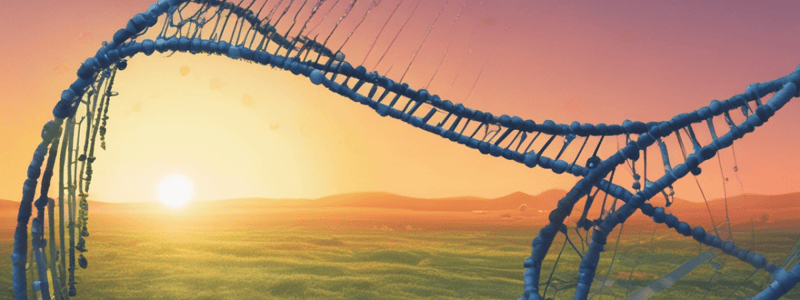Podcast
Questions and Answers
What is the purpose of adding a specific di-deoxynucleotide to each of the four reaction mixtures in Sanger sequencing?
What is the purpose of adding a specific di-deoxynucleotide to each of the four reaction mixtures in Sanger sequencing?
To terminate DNA synthesis at a specific point, allowing for the detection of the nucleotide at that position in the template sequence.
Why is a radioactively labelled primer used in Sanger sequencing?
Why is a radioactively labelled primer used in Sanger sequencing?
To enable the detection of the newly synthesized DNA strand through autoradiography.
What is the role of DNA polymerase in Sanger sequencing?
What is the role of DNA polymerase in Sanger sequencing?
To synthesize a new DNA strand by incorporating complimentary dNTPs into the template strand.
How does capillary electrophoresis contribute to the determination of the sequence in Sanger sequencing?
How does capillary electrophoresis contribute to the determination of the sequence in Sanger sequencing?
What is the advantage of using automated capillary sequencing over Sanger sequencing?
What is the advantage of using automated capillary sequencing over Sanger sequencing?
What is the purpose of using different colored dyes to label each ddNTP in automated capillary sequencing?
What is the purpose of using different colored dyes to label each ddNTP in automated capillary sequencing?
How is the sequence of the template strand determined in Sanger sequencing?
How is the sequence of the template strand determined in Sanger sequencing?
What is the significance of the negatively charged phosphate groups in DNA in the context of Sanger sequencing?
What is the significance of the negatively charged phosphate groups in DNA in the context of Sanger sequencing?
Flashcards are hidden until you start studying
Study Notes
Sanger Sequencing (Chain Termination Sequencing)
- Four separate reaction mixtures are set up, each containing:
- Single-stranded DNA with an unknown sequence
- Radioactively labelled primer (short sequence single-stranded DNA)
- DNA polymerase
- Normal nucleotides
- A specific dideonucleotide is added to each of the four reaction mixtures
DNA Synthesis
- Isolate single-stranded DNA with an unknown sequence
- Primer binds to template sequence (complementary known sequence) and is radioactively labelled
- DNA polymerase begins synthesizing new DNA strand by inserting complementary dNTPs
- DNA polymerase continues synthesizing DNA with dNTPs
- If ddNTP is present in the reaction tube, synthesis of the new DNA strand will be terminated
- Length of new DNA fragments synthesized in each tube is dependent on the template DNA sequence
Gel Electrophoresis
- Able to separate charged molecules based on size using capillary electrophoresis
- Sequence is determined based on fluorescent label on terminating nucleotides
- Phosphate groups of DNA have a strong negative charge
Autoradiography
- Visualized using X-ray film laid on top
Determination of New Strand Sequence & Deduction of Template Sequence
Automated Capillary Sequencing
- Similar to Sanger sequencing
- Uses radioactive-labelled primers
- Each ddNTP is labelled with a different colored dye
- Whole reaction takes place in one tube
- Uses capillary electrophoresis
- Advantages over Sanger sequencing:
- Unlabelled primers
- All in one tube
- Fewer pipetting steps
- False stops are not detected – fragments not determined by dideonulceotide
Finding the Sequence
- Sequence of template strand (5’ – 3’):
- Green: adenine
- Yellow: guanine
- Red: thymine
- Blue: cytosine
Studying That Suits You
Use AI to generate personalized quizzes and flashcards to suit your learning preferences.




